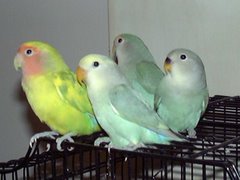Facts About Abyssinian Lovebird
The Abyssinian lovebirds are also called as Blue-winged lovebirds or Mountain parrots. They are native of Ethiopia. The zoological term for this bird is Agapornis taranta. They are usually 16 cm long. The males are green; brow red; beak dark red in color. But females are having no red color on the head. The young ones are having yellow-brown beak. The young ones don't have red color in the head until it reaches three or four months age.
These lovebirds are usually habitat of altitudes of up 3000 meters and are really hardiest species- able to withstand even the greatest frosts. They will be noticed in groups of ten during non-breeding season and leading a nomadic life. They are very rare in human habitation.

Abyssinians are imported only sporadically because parts of Ethiopia have export restrictions. They are not in great demand as they are not highly colored and also difficult to breed in captivity.
One of the breeder reported that the female carried ivy leaves in her plumage to the nest and formed a bed of 3 cm high. During the brooding period, the female and male will attack the other birds like cockatiels and red rump parakeets when they housed together.
Abyssinian lovebird's lay three to five eggs and the mother incubate the eggs for twenty-four to twenty-five days. Six weeks later the young leave the nest. The parents do not resent being observed during incubation.
These lovebirds are usually habitat of altitudes of up 3000 meters and are really hardiest species- able to withstand even the greatest frosts. They will be noticed in groups of ten during non-breeding season and leading a nomadic life. They are very rare in human habitation.

Abyssinians are imported only sporadically because parts of Ethiopia have export restrictions. They are not in great demand as they are not highly colored and also difficult to breed in captivity.
One of the breeder reported that the female carried ivy leaves in her plumage to the nest and formed a bed of 3 cm high. During the brooding period, the female and male will attack the other birds like cockatiels and red rump parakeets when they housed together.
Abyssinian lovebird's lay three to five eggs and the mother incubate the eggs for twenty-four to twenty-five days. Six weeks later the young leave the nest. The parents do not resent being observed during incubation.







 Free Ads For Bloggers
Free Ads For Bloggers


No comments:
Post a Comment